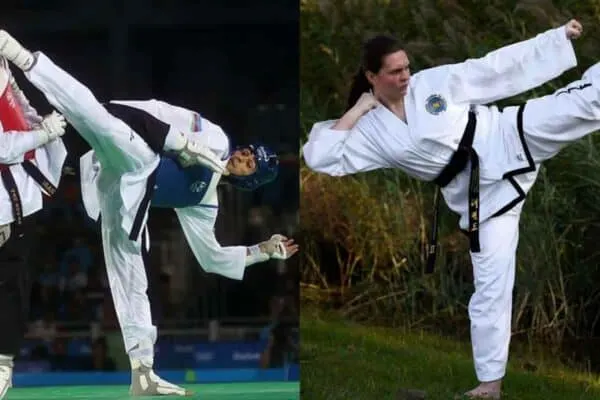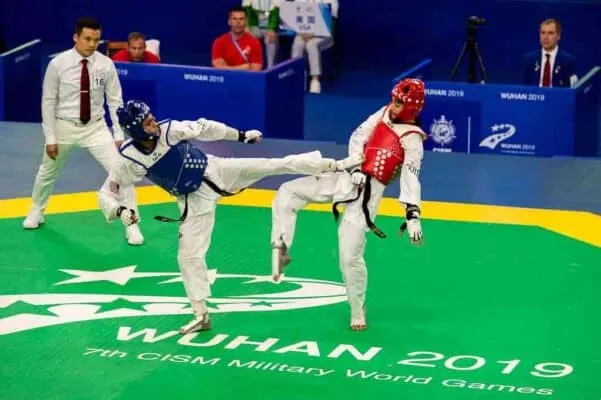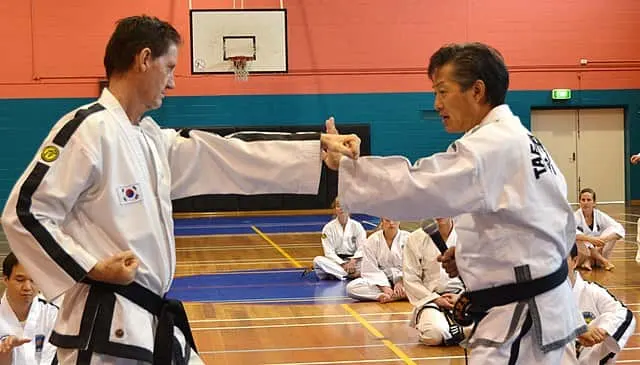
Taekwondo(TKD) has been a part of the Olympic Games since 2000, and the Olympic style of this Korean art is practiced by millions of people worldwide. But how this Olympic Taekwondo differs from the initial, traditional style developed in the 1950s in Korea? What are the key differences between these two styles?
Olympic Taekwondo is a sport style that emphasizes fast and precise striking, and the main goal is to prepare you to win points and matches in tournaments. On the other hand, the traditional taekwondo style focuses on self-defense, preparing you for full-contact fighting.
When people talk about Olympic vs. Traditional taekwondo, they are actually comparing two well-known styles – WT and ITF. Olympic Taekwondo (WT) is a sports style shaped and defined by the official rules, but the Traditional (ITF) style is a bit different. Practitioners of ITF utilize more techniques that aren’t allowed in WT rules.
Keep reading this article to learn more about how Olympic and Traditional taekwondo differ from one another.
What is Olympic-style taekwondo?
Olympic Taekwondo is also known as the “World Taekwondo (WT)” or sports Taekwondo. Its story started way back in 1972 when one of the largest academies called “Kukkiwon” was founded by the:
- Korean Taekwondo Association (KTA)
- Korean Ministry of Culture
- Korean Ministry of Tourism
A year later, in 1973, Kukkiwon and KTA would launch the new “World Taekwondo Federation (WTF).” The federation would change the name to “World Taekwondo (WT)” in 2017.

In 1974, they would also start taking initial steps toward making the Korean art a part of the Olympic Games. The major breakthrough came in 1988 when the sport had an official demonstration at Olympic Games in Seoul and 1992 in Madrid, Spain.
Just eight years later, in 2000, Taekwondo would debut as an official sport at the 2000 Summer Olympic Games in Sydney, Australia.
The Olympic style is very much the same as the WT style regarding concept, rules, and emphasis. The entire focus is on competition and learning how to utilize Taekwondo moves under strict rules to win matches. The emphasis is on:
- High level of technique
- Speed, precision, balance, and coordination of the moves
- Kicks to the torso and head of the opponent
- Punches to the torso
- Win matches, tournaments, and medals
What is traditional Taekwondo?
“Traditional style” stands for martial arts practiced by the nine main kwans (schools) in Korea in the 1940s and 1950s. This period was before the name “Taekwondo” came around, and this combat system was called “Tang Soo Doo.” Later, these nine kwans would unite to form the unified Korean martial art, changing the name from “Tang Soo Doo” to “Taekwondo.” And this initial style developed in the 1950s by nine kwans and general Choi Hong-Hi is what people consider “Traditional Taekwondo,” also known as ITF.

Photo by Muleta 68
ITF is a style created to improve the hand-to-hand combat abilities of Korean soldiers. Thus, the entire focus of this style is on self-defense and preparing you for different combat situations you may face on the streets. It is more in line with freestyle combat as it enables you to utilize all limbs as weapons to:
- Strike with kicks, punches, knees, and elbows
- Execute grappling moves such as trips, throws, and sweeps
- Apply dirty tactics such as eye gouging or groin strikes
- Defend against multiple attackers
- Handle basic weapons such as knives and staff
Training for real-life fighting differs a lot from training to win matches. Thus, traditional taekwondo is more direct, brutal, and powerful.
RECOMMENDED READING: Taekwondo Belt Ranking System – EASILY Explained For Beginners
Olympic TKD vs Traditional TKD – Key Differences Explained
Traditional and Olympic Taekwondo differ a lot in just about every aspect. Here is a detailed look at all the major differences:
Emphasis
Olympic TKD is a sports style where there are a lot of restrictions. It is a style defined by a particular set of rules, and there is very little self-defense training. The main goal is to apply limited taekwondo moves under the rules and win a match by scoring more points. Each skill, reactions, and habit students develop to win a competitive match.
The traditional TKD style differs significantly, focusing on self-defense and real combat. Its goal is to improve the hand-to-hand combat abilities of Korean soldiers. Unlike the Olympic style, it is more brutal and direct, and the entire training revolves around preparing you to defend yourself in the most efficient way possible.
Number of Techniques
Olympic Taekwondo rules are unambiguous, and players use far fewer techniques than in the traditional style. Kicks are primary weapons as, according to rules, win you the most points. Players also strike with their hands, but mostly with basic direct punches to the torso.
The traditional style is more versatile and includes more techniques. Students learn the same kicks and punches as in the Olympic style. They are also allowed to throw punches to the head and learn how to strike with knees and elbows at close range. Since punches to the head are allowed, they learn better defensive blocks.
Students of traditional style learn the basics of grappling like trips, sweeps, and throws from judo and how to handle various weapons such as knives and staff. The military version also teaches dirty tactics like eye gouging and groin strikes. Though brutal, these moves are effective and might help you get out of trouble on the streets.
Punches and blocks
Both styles include direct hand strikes with a clenched fist. However, the Olympic style only allows punches to the torso, while the traditional style enables you to hit both the torso and head of the opponent.
Learning to strike the head of the opponent means that people trained in the traditional TKD also tend to have better guards and blocks. Instead of keeping their hands up in fights, their colleagues from the Olympic style tend to keep their arms beside their bodies because they don’t have to worry about being punched in the head.
Kicks
Leg strikes are the primary weapon both in Olympic and traditional styles. But, the Olympic style only allows kicking attacks to the upper body and head, and the key is to land a kick with your foot.
The traditional style is a bit more oriented toward low and middle kicks and landing a kick with your heel or ball of the foot.
The speed of the kicks is also much faster in the Olympic style where athletes compete barefooted while in traditional they have to wear boots in competitions.
Gloves
In the Olympics, players wear open-fingered gloves made of thick polyester, similar to the ones used in MMA. However, in the traditional style (ITF), players wear boxing style full padded gloves.
RECOMMENDED READING: Karate vs. Taekwondo: Key Differences And Similarities
Olympic TKD vs. Traditional TKD – Differences in Competition Rules Explained
The Olympic WT and traditional ITF rules of taekwondo are very similar but differ in certain areas. Here is a detailed look at both of the rule sets:
Olympic Taekwondo (WT) rules:
- Full contact
- Free sparring
- Main objective: demonstrate a higher level of technique, speed, and precision and win the match by scoring more points
- Match duration: three rounds, with each round being two minutes long. One minute break between the rounds
- Legal strikes: kicks to the head and torso, punches to the torso
- Illegal strikes: kicks to the leg, punches to the head, elbows and knees
- Gear: A dobok uniform, WT-approved chest protector, headgear, groin cup, forearm and shin guards, gloves, sensing socks, and mouth guard.
- Points: 5 points for a spinning kick to the head. 4 points for a spinning kick to the torso. 3 points for a regular kick to the head, 2 points for a regular kick to the torso, one point for a punch to the torso
Olympic.com provides additional specific details about the Olympic TKD rules.
Traditional Taekwondo (ITF) rules are:
- Semi-free contact/full contact
- Free sparing
- Main objective: win the match by points or knock the opponent out.
- Legal strikes: punches to the torso and head; kicks to the torso and head
- Illegal moves: no knee and elbow strikes and kicks below the waist.
- Match duration: Each match has two rounds with each round being two minutes long (adults 18 years old or more)
- Protective gear: Gloves, boots, head gear, arm and shin guards (optional), mouth guard. There are also tournaments where players compete without the arm and shin guards.
- Points: 1 point for mid-section kick, or mid/high hand strike. 2 points for a high kick and jumping mid-section kick landed. 3 points for every clean jumping high kick landed.
You can read more details about ITF rules in the official ITF Rules of Competition booklet.
Olympic and ITF taekwondo rules are very similar. The biggest difference is the hand strikes and, of course, point fighting rules. Last but not least, ITF players wear less protective gear, and the matches have 1 round less than in Olympic style.
Olympic TKD vs. Traditional TKD – Which is Better for Self-Defense?
The traditional style is better if you want to learn Taekwondo for self-defense. Training entirely focuses on preparing you for actual combat you may encounter on the streets or other places. It trains your reactions, instincts, mind, and body for any intense situation. Olympic Taekwondo offers some benefits, but not as much as traditional TKD training.
The traditional style teaches you all about the physical and mental aspects of actual fighting. In training, students learn how to:
- Strike with various types of spinning and jumping low and high kicks
- Direct punches to the torso or head
- Basics of grappling such as trips, throws, and sweeps (from judo)
- Apply dirty tactics
- Deal with common weapons
But apart from mastering all the moves to perfection, students spend a lot of time doing self-defense drills. They also simulate real attacks and, of course, do lots of sparring.
This part of training is crucial as you can’t develop automatic reactions and learn to stay calm in a fight without doing live drills. And in most schools, they also spar versus multiple opponents, which adds to the realism of traditional training.
RECOMMENDED READING: Is Taekwondo Effective in a Street Fight? Q&A
Why is Olympic TKD not effective for self-defense?
Olympic Taekwondo differs a lot as the entire focus is on the competition. Thus, the skills you develop are not as practical regarding self-defense. In addition, the skills you develop, habits, reactions, and instincts to “fight” under the rules do not transition well into real-life fighting.
For example, due to the lack of punches to the head, athletes trained in the Olympic style have a bad habit of keeping their arms low beside their bodies. Keeping your hands down and your chin fully exposed in a street fight is dangerous. So in some way, the lack of advanced punching offense and defense is the biggest downside of Olympic Taekwondo against being considered a realistic style in self-defense situations.
Olympic TKD vs. Traditional TKD – Which is better?
These two styles differ a lot in just about all aspects. So which is better for you comes down to your personal preference, which might sound very cliche. The good news is that this is still the same martial art, and you can always switch from one style to other one and adapt very quickly. So you won’t make a mistake choosing any of the two.
If you are a competitive person and want to win matches and tournaments, then the WT style of Taekwondo should be your choice, as WT style and rules are the ones used in the Olympics.
Training in an academy that embraces sports taekwondo training is how you develop the skills for competition. Later on, winning international WT tournaments and medals is how you can secure a spot in the Olympic Games.
Traditional, or ITF taekwondo style is for people who want to get the whole Taekwondo experience and develop solid self-defense skills. It is a more versatile style where the entire focus is on self-defense training. But on the other side, ITF also includes competitions where you can test your skills against other students if you want.
Related Questions
Are you allowed to punch in Olympic TKD tournaments?
Yes, Olympic rules enable Taekwondo players to throw punches just to the upper body below the neck (torso). A single well-placed punch to the torso wins you 1 point, while kicks win you between 2 and 5 points. Kicks award more points, which is why kicks are the primary weapons in Olympic taekwondo and why players rarely throw any punches.
Landing punches to the head is not allowed under Olympic rules, but it is allowed under ITF rules.
What is not allowed in Olympic Taekwondo?
Olympic Taekwondo players are not allowed to strike with elbows and knees, just with punches and kicks. They are also not allowed to throw kicks below the waist (low kicks), land a kick with the shin or any other part rather than a foot, and throw punches to the head. In defense, they can’t use their leg to prevent an offensive kick or hold their leg up for more than three seconds to hinder their opponent’s movement.
Players are penalized for crossing the boundary line with both feet, falling to the ground, trying to push their opponents, or attacking the grounded opponent.
Who is the best taekwondo player of all time?
Steven Lopez
Lopez is not just one of the greatest Taekwondo players of all time but also one of the greatest USA athletes. In his long career, he won Taekwondo World Championship a remarkable six times. On top of that, he won the Olympic gold medals twice at the 2000 Sydney and 2004 Athens Olympic Games and one bronze medal at the 2008 Beijing Olympics.
Hadi Saei
Saie is one of the most successful athletes from Iran and the Olympic gold medalist in Taekwondo on two occasions. He won the first gold medal at the 2004 Olympic Games in Athens and the second gold in 2008 in Beijing. He also won the prestigious Taekwondo World Championships two times.
Hwang Kyung-Seon
Kyung-Seon is a two-time Olympic Champion. She won the first gold medal at the 2008 summer Olympic Games and the second gold medal at the London Olympic Games in 2012. While representing South Korea, she also won two World Championships in 2005 and 2007.
